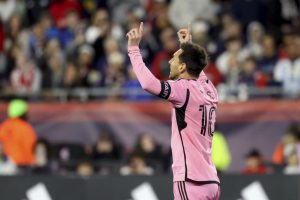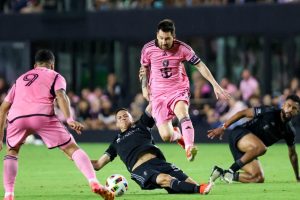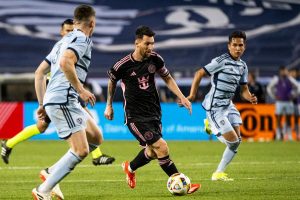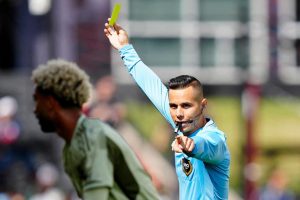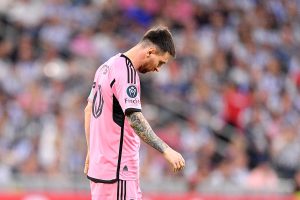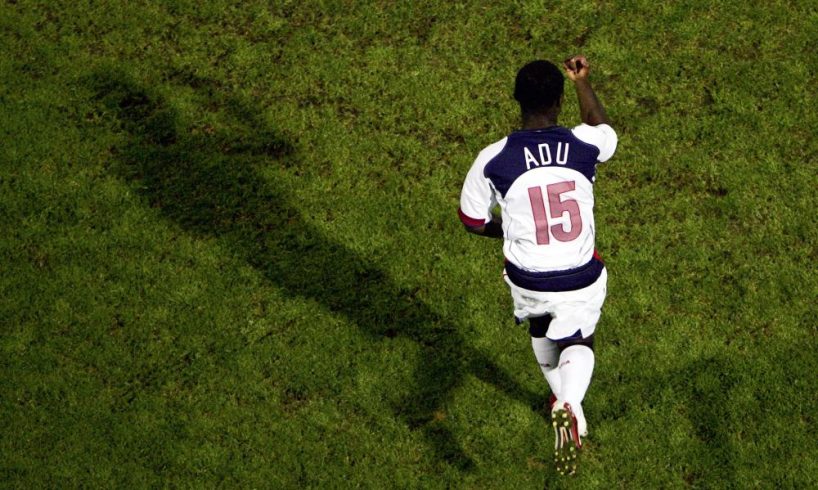
Freddy Adu is the youngest player to have represented the US men’s national team.Photograph: Donald Miralle/Getty Images
In the summer of 2007, Freddy Adu had reached a crossroads.
He was on his way back from the 2007 Fifa Under-20 World Cup in Canada, at which he’d played the best football of his career – a career now almost four years old, despite the fact he’d turned 18 just a month earlier, and one comprised first of immeasurable hype and latterly of disappointment.
The US had reached the quarter-finals, where they were beaten by Austria. It was a modest run for a talented squad. But Adu has shone brightly throughout, captaining the side as he scored a hat-trick against Poland and dazzled with his trickery and creativity in upset victories over Brazil and Uruguay.
He’d impressed sufficiently that, despite an underwhelming six months with Real Salt Lake in MLS, Benfica made a $2m offer for his services. A fresh start in Portugal with one of the giants of European soccer was an enticing prospect for a player who’d spent a considerable chunk of his young life fighting to justify the hype thrust upon him.
“At the airport after the 2007 World Cup, I was pleading with his agent not to sign with Benfica,” says Thomas Rongen, the former US under-20s coach. “I knew Benfica was too big of a step for such a young player. And it proved to be the wrong move. He got loaned out six times in a four-year period.”
It was a move that also sparked the slow decline of Adu’s career. He would sign – either through loans or permanent transfers – for 13 clubs in nine different countries over a 14-year span. A season-and-a-half return to MLS with Philadelphia Union in 2011 brought promise of a latent realisation of his potential, but such hope was short-lived. Adu’s career wound down through spells in Finland, Serbia and sub-MLS leagues in the US, ending finally in 2021, after two years out of the game, with Österlen FF in Sweden’s third tier.
It was a sad end to a career that, at its outset, had promised more than any other.
Born in Ghana, Adu moved to Rockville, Maryland, at eight when his mother, Emelia Adu, was granted a US green card through the Diversity Immigrant Visa programme, known as the green card lottery. He became a local soccer standout, impressing against older, bigger opponents and was offered a place at the IMG Academy, a preparatory boarding school in Florida where some of the nation’s most promising young athletes are nurtured. It was there that he first came to Rongen’s attention.
“He had the same stature as Messi, a great dribbler,” the coach says. “He was very unpredictable, and for an American player we’d never seen anything like that. He manhandled players and teams in his own age group when he was 14, 15, domestically and on the international level. He could assist and score with ease.
“In 2003, a year before Freddy singed to MLS, I took him to the [Under-20] World Cup. Freddy was 14 at that time. I took him not necessarily to play a lot of minutes but to get a taste of what the Under-20 World Cup and the next phase in his career would be like. I knew he would be one of my better players in the next cycle. He showed very early that he belonged. He played quite a few minutes in that World Cup. With that success, I think MLS said, ‘Wow, this 14-year-old …’ And he entered MLS a few months after.”
Major League Soccer, desperate for a first homegrown superstar to help legitimise the league globally, fast-tracked Adu’s ascent to the professional ranks. It was determined that he would join DC United, the club closest to his home in Maryland, as the first pick in the 2004 SuperDraft. The Dallas Burn, who originally owned the top selection, received player compensation for allowing DC to jump the queue. With the signing agreed months in advance, Adu trained with his soon-to-be DC United teammates in the months before his full-time arrival.
“He was a breath of fresh air,” recalls Ray Hudson, DC’s manager at the time. “He came in with a real smile, a real effervescent personality. He wasn’t the braggadocios type; he was a bit shy if anything. But he had this wonderful personality.
“He had extreme confidence on the ball, with a real sharp ability. His first touch, control was extremely good. He didn’t particularly elaborate in the days that I saw him. It wasn’t like you were watching the new Messi. It wasn’t like he would slalom through two or three players. He didn’t try that. That, for me, was a sign of his footballing smarts. He didn’t look to do any more than he needed to do, but what he did, he did very quickly and very well.
“A couple of times there was a drop of the shoulder, a shift of the weight – the sort of things that separate the good players from the very, very good players. He showed that in glimpses. I distinctly remember thinking, ‘OK, I see what the buzz is.’”
Not only would Adu, still just 14, become the youngest professional athlete in this history of US major sports, his $500,000-a-year contract made him the highest-paid player in MLS. The hype train was off and running. Labelled the ‘new Pelé’, he became the face of numerous off-field endorsements – including a million-dollar deal with Nike and a star role opposite Pelé himself in an ad for Sierra Mist.
“In the first year in MLS, DC United, contractually, had to play him at least a few minutes every game, particularly on the road,” Rongen says. “Freddy Adu was just like Messi or Beckham – on the road there were 40,000 people chanting ‘Freddy, Freddy, Freddy’. Peter Nowak [who replaced Hudson as DC United coach for Adu’s debut season] told me, ‘I had to play him 10 minutes, at least, every game.’
“We tried to protect him as much as we could, but you just couldn’t get away from it. Anywhere we went in the world, particularly after he’d signed to MLS and had sponsorship deals, the spotlight was Freddy Adu, like it is with Messi now. I remember we played the Haitian national under-20 team in Fort Lauderdale. There were 18,000 people. People were coming to watch us practice.
“I liked that it brought attention to the team and to the league,” adds Santino Quaranta, another of DC’s promising young players at the time. “We all knew what he was going to have to sustain. And I wasn’t so sure that it was going to be sustainable. We’d been around long enough to understand that this kid is a good player, but not to this magnitude.
“For the amount of stress and pressures that he had, he had a tremendous ability to always smile. I think it was mechanism of fear. He didn’t have many tools to deal with all that as a kid, but he was always smiling.”
In his first season, Adu appeared in all 30 regular-season games, scoring five goals and providing three assists, as DC won the MLS Cup. A senior international debut arrived in January 2006, when came off the bench in a friendly against Canada to become the youngest player ever to represent USMNT, at 16 years and 243 days.
Despite back-to-back selections for the MLS All-Stars – once as a commissioner’s choice and once at the behest of Nowak, who coached the All-Star’s against Chelsea in 2006 – subsequent campaigns at club level were less successful. The teenager became frustrated with featuring predominantly as a substitute, which he believed cost him a place at the 2006 World Cup.
A trial with Manchester United that year bore no fruit for Adu, and in 2007, after a total of just six goals in his final two years in DC, the one-time face of the league was traded unceremoniously to Real Salt Lake.
“There were so many things surrounding him that didn’t help him focus on the task at hand,” Rongen says of Adu’s failure to live up to expectations. “It was not his fault. It was more due to MLS. He became this creation. The ‘next Pelé’. The ‘saviour of MLS’. It became a burden for him. All of a sudden, you see the downward spiral.
“In MLS at DC United, it proved a tough transition for him, to go from happy-go-lucky to, ‘OK, every day I’ve got to fight for my position.’ I knew emotionally and physically he was not ready for that.”
“When I think back to it, I had some guys that helped me along really well, but it was a different situation [with Freddy],” Quaranta adds. “He wasn’t mature enough to understand. He never had a super-close bond with any of the older guys. It wasn’t by choice. It was just who he was. A lot of guys helped him along and nobody did anything to hurt him. But there was never one guy who helped him along and said, ‘Look, this is how to do it.’
“He was under a lot of pressure. You could see it was wearing on him. Once people are paying to see you play, you’ve got to produce. You’ve got to be entertaining. I think that started to weigh on him. He struggled to maintain that level of fame. When you’ve tasted it and felt it, then it’s not there any more and people are telling you you’re shit, it’s hard.”
Adu sought solace in the US’s under-20s set-up. It was an environment he knew well, making 30 total appearances for the team between 2003 and 2009 and scoring 16 goals. By the time the 2007 Under-20 World Cup rolled around, Adu, now 19 years old, was a veteran of the side and, for once, playing among peers. It was his safe haven.
“He couldn’t wait to get away from Real Salt Lake,” Rongen says. “It all started at DC United. He walked into that locker room with the ‘saviour’ tag and with a million dollars from Nike. The senior pros all went, ‘Who the fuck are you? Show us.’ And he didn’t understand why they’d kick him in training. He wasn’t prepared for that, physically and mentally.
“Come the 2007 World Cup, that’s when he really excelled because he was so happy, so free, so comfortable in his own skin with his own age group. Coming back among his peers, when he could laugh and enjoy himself, he was just exceptional. I was so happy that he was happy.
“He was so special. He was always the best player on the field. When we played Brazil with Marcelo and David Luiz, and we played Uruguay with Edinson Cavani and Luis Suárez, Freddy Adu was the fucking man. I got a false sense of reality because he competed at the highest level with such ease. I thought he was such a special talent that it would carry him through, but it didn’t happen when he arrived at Benfica.”
In 2015, 12 years after they’d first worked together, Adu and Rongen were reunited. The former youth coach was in charge of the Tampa Bay Rowdies in the now-defuct North American Soccer League. Adu was still only 26 years old, but his name no longer elicited excited whispers among the US soccer community. He was instead a walking cautionary tale.
He called Rongen in search of an opportunity; one last chance to prove that he was, after all, what people once believed he could be, and not what they now said he’d become.
“He was really down and out,” Rongen says. “He was somewhere in Scandinavia when he called me. He said, ‘Coach, I’ve recommitted myself to playing the game at the highest level. You’ve always been one of my biggest supporters.’ So I brought him to the Tampa Bay Rowdies.
“He never really progressed in what was important for him to sustain the rigours of modern football. He never grasped that concept. He didn’t train the way a great player should. He never overcame that initial three or four years as a pro, where he got slapped around, where he was the saviour of MLS, the next Pelé.
“Unfortunately, I was let go and that also became the end of Freddy Adu. He eventually played for Las Vegas and somewhere back in Scandinavia, then called it quits in 2021.”
Seventeen senior international caps, an MLS Cup winner’s medal and more than 200 professional games played ought to represent a career of high achievement, a success story of a young boy who, through a preternatural sporting talent, lived the American dream. But the bar was set so high, so early for Adu that anything short of all-time greatness would always fall short.
By the time he hit his 20s, he was too far behind those expectations to ever catch up. At 28, he took a trial with Polish club Sandecja Nowy Sacz that the team’s manager called “a joke”.
“After all those experiences, he was never the same happy Freddy,” Rongen concludes. “He was a jaded guy that verbalised that he wanted to go back to the highest level and he wanted to do that. But he just didn’t know how.
“I think he lost his passion and his joy for his first love, the game of football.”


